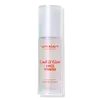What's inside
What's inside
 Key Ingredients
Key Ingredients

 Benefits
Benefits

 Concerns
Concerns

 Ingredients Side-by-side
Ingredients Side-by-side

Water
Skin ConditioningC12-15 Alkyl Benzoate
AntimicrobialPropylene Glycol
HumectantGlycerin
HumectantMica
Cosmetic ColorantPropanediol
SolventBis-PEG-12 Dimethicone
EmollientBoron Nitride
AbsorbentSodium Acrylates Copolymer
Pentylene Glycol
Skin ConditioningLactococcus Ferment Extract
Skin ConditioningLactobacillus/Brassica Nigra Seed Ferment Extract
Skin ConditioningQuercus Petraea Fruit Extract
Skin ConditioningHydroxyacetophenone
AntioxidantLecithin
EmollientPolyacrylate Crosspolymer-6
Emulsion StabilisingSynthetic Fluorphlogopite
Amylopectin
Calcium Lactate
AstringentTin Oxide
AbrasiveXanthan Gum
EmulsifyingCitric Acid
BufferingDisodium EDTA
Sodium Benzoate
MaskingCI 77891
Cosmetic ColorantCI 77491
Cosmetic ColorantWater, C12-15 Alkyl Benzoate, Propylene Glycol, Glycerin, Mica, Propanediol, Bis-PEG-12 Dimethicone, Boron Nitride, Sodium Acrylates Copolymer, Pentylene Glycol, Lactococcus Ferment Extract, Lactobacillus/Brassica Nigra Seed Ferment Extract, Quercus Petraea Fruit Extract, Hydroxyacetophenone, Lecithin, Polyacrylate Crosspolymer-6, Synthetic Fluorphlogopite, Amylopectin, Calcium Lactate, Tin Oxide, Xanthan Gum, Citric Acid, Disodium EDTA, Sodium Benzoate, CI 77891, CI 77491
Water
Skin ConditioningCaprylic/Capric Triglyceride
MaskingPropanediol
SolventOctyldodecanol
EmollientButylene Glycol
HumectantSodium Acrylates Copolymer
Menthyl Lactate
Masking1,2-Hexanediol
Skin ConditioningDiglycerin
HumectantMenthone Glycerin Acetal
RefreshingLecithin
EmollientHydroxyacetophenone
AntioxidantTin Oxide
AbrasiveVaccinium Myrtillus Seed Oil
Skin ConditioningMica
Cosmetic ColorantTitanium Dioxide
Cosmetic ColorantIngredients Explained
These ingredients are found in both products.
Ingredients higher up in an ingredient list are typically present in a larger amount.
Hydroxyacetophenone is antioxidant with skin conditioning and soothing properties. It also boosts the efficiency of preservatives.
This ingredient is not irritating or sensitizing.
Lecithin is a term for a group of substances found in the cell membranes of plants, animals, and humans. They are made up of mixture of phospholipids.
This ingredient has emollient and emulsifying properties.
As an emollient, lecithen helps soften the skin and creates a barrier to keep moisture in.
As an emulsifier, it also helps prevent water and oil ingredients from separating. Lecithin can also help ingredients be better absorbed by the skin.
This is because the phospholipids in lecithin produce liposomes. Liposomes help other ingredients get through the skin barrier.
Depending on the source of this ingredient, lecithin may not be fungal acne safe. This is because some sources of lecithin come from soybean oil, which may feed the malassezia yeast that feeds fungal acne.
We recommend reaching out to the brand you are purchasing from to inquire about the source of their lecithin.
Some other names for this ingredient include soy lecithin and deoiled soy lecithin.
Learn more about LecithinMica is a naturally occurring mineral used to add shimmer and color in cosmetics. It can also help improve the texture of a product or give it an opaque, white/silver color.
Serecite is the name for very fine but ragged grains of mica.
This ingredient is often coated with metal oxides like titanium dioxide. Trace amounts of heavy metals may be found in mica, but these metals are not harmful in our personal products.
Mica has been used since prehistoric times throughout the world. Ancient Egyptian, Indian, Greek, Roman, Aztec, and Chinese civilizations have used mica.
Learn more about MicaPropanediol is an all-star ingredient. It softens, hydrates, and smooths the skin.
It’s often used to:
Propanediol is not likely to cause sensitivity and considered safe to use. It is derived from corn or petroleum with a clear color and no scent.
Learn more about PropanediolWe don't have a description for Sodium Acrylates Copolymer yet.
Tin Oxide is an inorganic oxide used to add opacity and volume to a product. In nature, it is already found in mineral form. The main ore of tin is an opaque and shiny mineral called casseterite.
Tin Oxide helps remove translucency in a product, or make it more opaque. Besides adding opacity, tin oxide is used for bulking to add volume.
Water. It's the most common cosmetic ingredient of all. You'll usually see it at the top of ingredient lists, meaning that it makes up the largest part of the product.
So why is it so popular? Water most often acts as a solvent - this means that it helps dissolve other ingredients into the formulation.
You'll also recognize water as that liquid we all need to stay alive. If you see this, drink a glass of water. Stay hydrated!
Learn more about Water